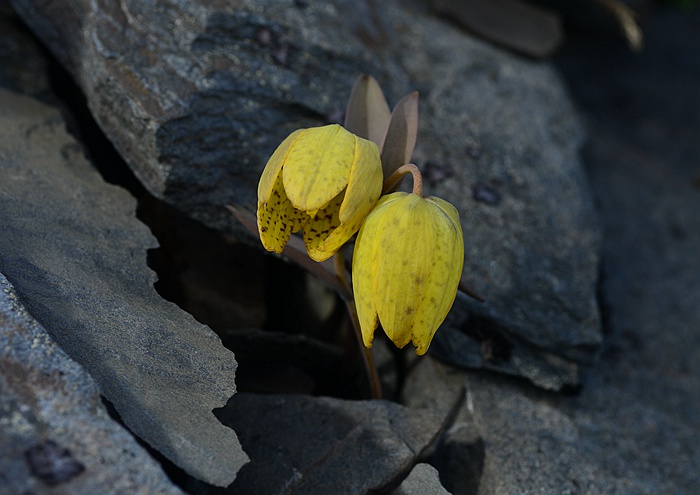- Scientific Name: Fritillaria delavayi Franch.
- Ref: J. Bot. (Morot) 12:222. 1898
- Synonyms: Fritillaria bhutanica Turrill; F. delavayi var. banmaensis Y.K.Yang & J.K.Wu; F. xizangensis Y.K.Yang & Gesan
- Chinese Common Name: 梭砂贝母 suōshā bèimǔ, 德氏贝母 Dé-shi bèimǔ, 炉贝 lúbèi, 雪贝母 xuě∙bèimǔ, 雪山贝 xuěshān∙bèi
- Family: Liliaceae
- Genus: Fritillaria
- Distribution: Sandy and gravelly places, flood lands; 3400–5600 m. Qinghai, Sichuan, Xizang, Yunnan [Bhutan, Sikkim].
- Photo: 06/23/2014, Daxueshan, Yunnan
Bulb of 2 or 3 scales, subglobose or ovoid, 1--2 cm in diam. Stem 15--35 cm, often covered with a waxlike layer near base. Leaves 3--5, closely arranged in middle or distal part of stem, alternate or subopposite; leaf blade ovate or ovate-elliptic, 2--7 × 1--3 cm, apex obtuse or rounded. Inflorescence 1-flowered. Flower campanulate; pedicel long. Tepals yellowish, spotted or tessellated with reddish brown, narrowly elliptic or oblong-elliptic, 3.2--4.5 × 1.2--1.8 cm; nectaries inconspicuous. Stamens 1.6--2.2 cm; filaments glabrous; anthers basifixed. Style 3-lobed; lobes 0.5--4 mm. Capsule narrowly winged, ± enclosed by persistent tepals. Fl. Jun--Jul, fr. Aug--Sep. (Flora of China)
